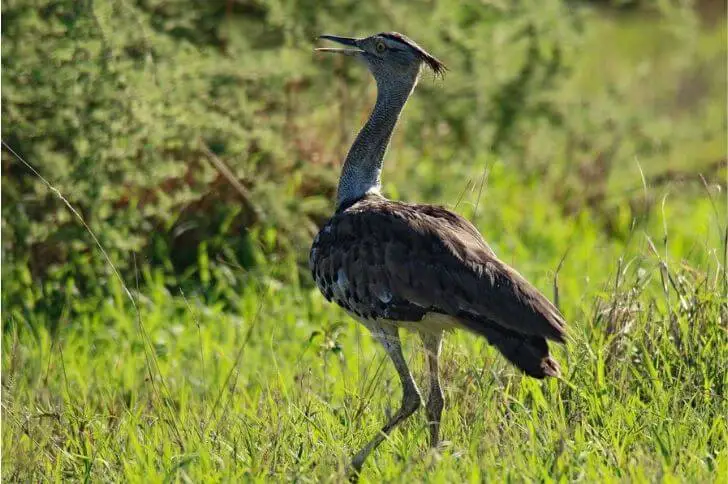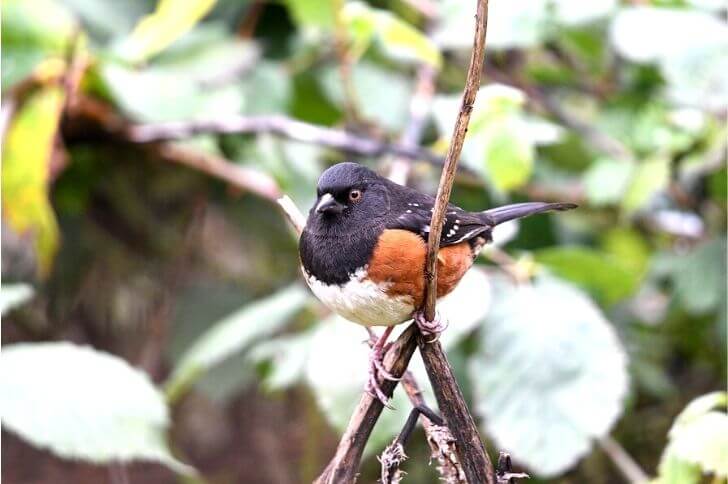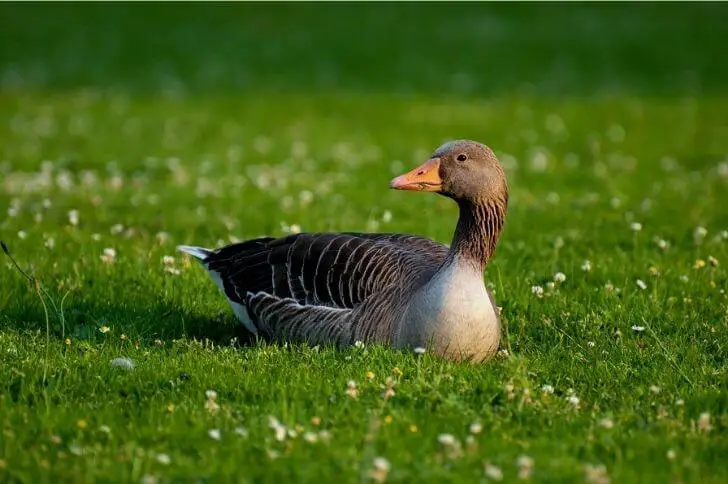Like animals, bird names also begin with different letters. In the article below we’ll look at different birds that start with k. These include popular birds like the Kentucky warbler to lesser known birds like the Kipengere seedeaters.
This list of birds beginning with k consists of mostly less known birds so you can include them in your bird watching list. Also, if you are a birder we’ve listed ‘most commonly found regions’ so you can plan your next bird watching trip with ease.
Birds that start with K
1. Kagu
In New Caledonia there is a 23-inch bird that is known for its very unique crest. The kagu is the only surviving member of the Rhynochetidae family and was once thought to be extinct.
And, apart from its unique crest there are other features that make this bird standout from the other birds in these dense forests. First, the bird has binocular vision. It’s a bird of prey, so this comes in handy when hunting.
Second, during the breeding season, the female lays one egg which is incubated by both parents. It’s really interesting. Each parent stands on guard for at least 24 hours.
Lastly, it is an almost flightless bird, meaning it spends more of its life on the ground than flying unlike other birds of prey.
Notice its similarly colored bills and legs? Looks beautiful. The kagu feeds on insects, spiders, lizards, and small rodents.
2. Kakapo bird
One of the oddest birds of New Zealand is the Kakapo. Also called the owl parrot, it is the world’s heaviest parrot at about 4 pounds. The males are larger than females.
When you first come across this unique parrot, you’ll notice its bizarre reaction to people. It freezes at the sight of humans or predators. Kind of like a deer in headlights.
This is a defense mechanism, it hopes to blend in with the surrounding nature so that it is not noticeable.
This nocturnal bird has strong legs and a stout body. Its plumage is mostly green. Kakapo have large, round heads with featherless faces and prominent beaks.
Kakapo feed on seeds, fruits, and invertebrates. They nest in hollow trees or logs on the ground. The female typically lays two eggs which hatch after about 28 – 30 days incubation by both parents. The chicks remain with their parents for up to 6 months.
3. Karoo chat
There are numerous medium-sized birds from Africa and the karoo chat is one of them. We recently looked at the isabelline shrike in the list of birds that start with g. The two birds share similar colors but the karoo is slightly larger.
These birds with k are usually gray or brown in color, and have shades of black on their tails. The birds live in open areas such as grasslands and savannas, and eat insects and other small animals.
Karoo chats are very social birds, and can often be seen in large flocks. They are also known for their loud calls, which can be heard from far away.
4. Karamoja apalis
Another bird that starts with k that you will see on your next safari is the karamoja apalis. This passerine is endemic to East African countries.
This ash-gray bird features lighter underparts and darker upperparts. They live in pairs and reside in shrublands.
5. Kalij pheasant
Kalij pheasants are one of the most beautiful and exotic birds in the world. Notice the striking red patch on the eye? They are native to parts of Southeast Asia, and they are known for their gorgeous blue- black and white feathers.
These pheasants are shy birds, and they are not often seen in the wild. They prefer to stay in heavily forested areas, where they can find plenty of food and safe places to hide. They eat a variety of things, including seeds, fruits, insects, and small animals.
They are also known for their loud calls, which can be heard from far away. The sexes are different from each other. Females are brown with some hints of gray while males are silver and black.
Related: Here is a list of birds that start with i
6. Karoo lark
The lark family is made of 99 species including the karoo lark. This small brown bird that is found in the arid regions of southern Africa.
It is named after the karoo region, a semi-desert area in S.Africa. This type of lark is a ground-dwelling bird that feeds on insects and seeds.
It has a loud, ringing call that can be heard from a great distance. It builds a simple nest of grasses near the ground. It lays two or three eggs, which are incubated by the female. The chicks are fed by both parents and are able to fly within two weeks of hatching.
7. Kashmir nuthatch
There are hundreds of nuthatches and the Kashmir nuthatch is part of this remarkable group of birds.
This nuthatch is a small bird with dark gray upperparts and stunning orange underparts. The sexes share similar features and colors, the only way to differentiate them is females tend to have paler plumage.
Kashmir nuthatches live in pine forests, where they eat insects, seeds, and nuts. They are monogamous birds, and both the male and female take care of the chicks.
8. Karoo prinia
Another streaked bird you’ll see across the semi-arid areas of South Africa is the karoo prinia. It is closely related to the karoo lark and common prinia, and has a similar appearance, but is slightly paler below.
This timid bird measures about 5.9 inches in length and has stunning dark brown eyes. It produces sharp calls; “kli” sound is repeated several times.
9. Kentucky warbler
Want to go bird watching in Kentucky? This state is home to some very interesting birds including the bright yellow Kentucky warbler.
This migratory songbird breeds in temperate forests of eastern North America. The male Kentucky warbler is easily recognized by its bright yellow breast and black head, while the female is predominantly olive green.
During the fall and winter, the Kentucky warbler can be found in tropical forests throughout Central America and South America. If you are a bird enthusiast, this is a bird you must see.
10. Kermadec petrel
Related to jaegers, the kermadec is a seabird that boasts of 39.4 inch wingspan. Yes you read that right. Found in Hawaii, it is a medium-sized petrel that comes in different shades.
Some birds are all white, others have dark heads and white bodies and yet others are all dark, but whatever the shade, they all belong to this group of birds.
The Kermadec petrel feeds mainly on squid, but also eats fish and crustaceans. It nests in colonies on offshore islands, laying one or two eggs. It has two breeding seasons. Next time you visit Hawaii, save some time and visit the Kilauea Point National Wildlife Refuge where you’ll find these birds. Check other Hawaiian birds
11. Kelp goose
Canada is home to several types of geese. The Kelp goose is the smallest of these geese, measuring only around 24 inches in length and weighing about 5.6 pounds.
These birds are sexually dimophic. Females are all black on the back and have a patterned belly. Males are all white with yellow feet and black beak.
Their nest is a simple scrape on the ground lined with feathers and down, and 4-7 eggs are laid. The young goslings are able to fly within 2 months after hatching. Kelp geese feed on aquatic plants, including algae and seaweed, as well as insects and small fish.
12. Kawall’s amazon
Kawall’s amazon is a spectacular parrot that is found in the rainforest of South America. This bird is a member of the Amazona genus and is known for its bright green plumage and striking red band on the sides of its tail.
Kawall’s amazons are social birds that live in small flocks and are often seen foraging for food in the upper canopy of the rainforest. These birds are highly intelligent and can be taught to speak a variety of words and phrases. Kawall’s amazons make excellent pets and are considered to be one of the most beautiful parrots in the world.
13. Kenya sparrow
East Africa has plenty of small birds and in Kenya you’ll find this sparrow bird. The sexes are similar, but juveniles are paler than adults.
The Kenya sparrow is a gregarious species, usually found in small flocks or large colonies. It feeds on seeds and insects, and often gathers around human settlements to scavenge for food. Nests are built in trees or bushes, and usually contain three or four eggs.
14. King eider
The king eider is a migratory bird that can be found in the Arctic and subarctic regions . The male king eider is easily identified by its black and white plumage with a large orange patch on its head close to the beak and orange nape. It’s really hard to miss. Also the ‘sails’ on their back really standout.
The females are predominantly brown. These ducks feed primarily on aquatic invertebrates, but will also consume plant material. They are known to form monogamous pairs which remain together for multiple seasons.
During the breeding season, the males will build nests out of grasses and other materials on top of elevated sites near water. The females will lay between 4-10 eggs in these nests, which the males will then incubate for approximately 25 days. After hatching, both parents will care for the young until they are able to fly and hunt on their own.
15. Kilombero weaver
Weaver birds are not hard to identify, especially the Kilombero weaver. The male has bright yellow plumage similar to the Kentucky warbler. Females have streaked backs with pale underparts.
Endemic to southern Tanzania, they weave intricate nests out of grass. These birds are sociable and have the same songs as other weaver varieties.
16. Kurrichane thrush
As a member of the thrush family, the Kurrichane thrush produces a variety of whistles and fluting notes that are pleasing to hear.
This orange-billed bird features a gray upperpart and orange underparts. Note the orange ring around its eye that is quite eye-catching (pun intended). The Kurrichane thrush feeds on insects, spiders, and other small animals. The bird is found in open woodlands and savannas.
17. Kori bustard
Looking for unique birds that start with k? I think the Kori bustard is the most unique bird beginning with k.
From its long neck and legs to its speckled wings, there is plenty to learn and love about this ground bird.
Being one of the largest birds in Australia and Africa, this unique bird measures up to 4 feet in length and has a massive wingspan of up to 9fT. Pretty massive. Males can weigh up to 40 lb which is impressive. They live in open areas such as grasslands and savannas. They are mostly quiet unless threatened.
18. Kofiau monarch
The black-backed-monarch or Kofiau monarch is a small bird found in lowland forests. It is the only member of the Monarcha genus. The Kofiau monarch is about 5 inches long and has mainly black plumage with a breast and belly. Its face and throat are darker compared to the back. The sexes are similar in appearance, but young birds are duller than adults.
19. Kretschmer’s longbill
When you first come across the Kretschmer’s longbill, you may think it’s not part of the warbler family. I did too until I dug a little deeper and found out more about this bird .
Though this bird has a long beak and darker plumage, it is infact a warbler. Like other warblers it prefers humid forests. It’s also known for its whistling sounds that are repeated 4 – 5 times.
20. Kosrae fruit dove
There are many different types of birds in the world, and each one has its own unique features and characteristics. The Kosrae fruit dove is a mid-sized bird that is found in lowland forests.
This dove has a beautiful light green color on its underparts and darker green on its upperparts. The tail also features yellow highlights on its end.
The Kosrae fruit dove is a very quiet bird, and it seldom makes any noise. It feeds on insects and small fruits, and it can be found in trees or shrubs near water. This dove is monogamous, meaning that it mates with only one partner for life.
The female builds the nest out of twigs and leaves, and she incubates the eggs until they hatch. The young chicks stay with their parents for several months after they are born.
21. Knob-billed fruit dove
Kosrae fruit dove is easy to spot due to its distinguishable purple crown. And instead of a crown, its cousin, the knob-billed fruit dove, is easily distinguished by a red knob above its beak.
This group of birds that start with k are found in forest and woodland. This plump, rotund bird, typically measures about 9 inches in length with a short tail. The bill is stout and curved. Its diet consists of fruit and seeds.
22. Kirtland’s warbler
The Kirtland’s warbler is a small North American songbird that breeds in northern Michigan. The male has a beautiful gray back with a mix of black while the underparts feature a beautiful lemon green color. Females share a similar plumage, though lighter.
Their diet consists mostly of berries, especially snowberries and lantanas. These rare warblers are a must-see for any birder living or visiting Michigan.
23. Kipengere seedeater
Kipengere seedeater, a small bird, is endemic to the highlands of central Tanzania. It is a shy and retiring bird which is usually found in pairs or small groups. Kipengere seedeaters feed on seeds and insects.
Sources:
https://www.ducks.org/hunting/waterfowl-id/king-eider
https://avibase.bsc-eoc.org/species.jsp?avibaseid=DBAB527C7B084696
Hi fellow bird watcher. Welcome to our small corner of the world. At the spanishbirdguides.com our mission is to share with other bird watchers the things we love about birds, where to go bird watching within the United States, and more. I’d also love to hear from you. Feel free to contact me about your bird watching escapades, share videos, photos and more.




